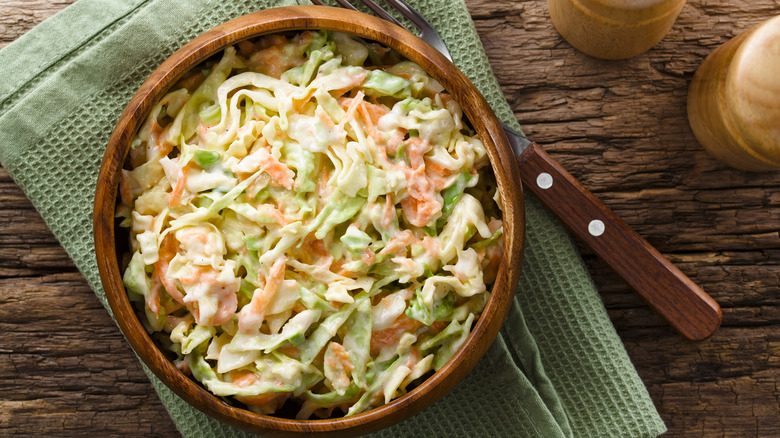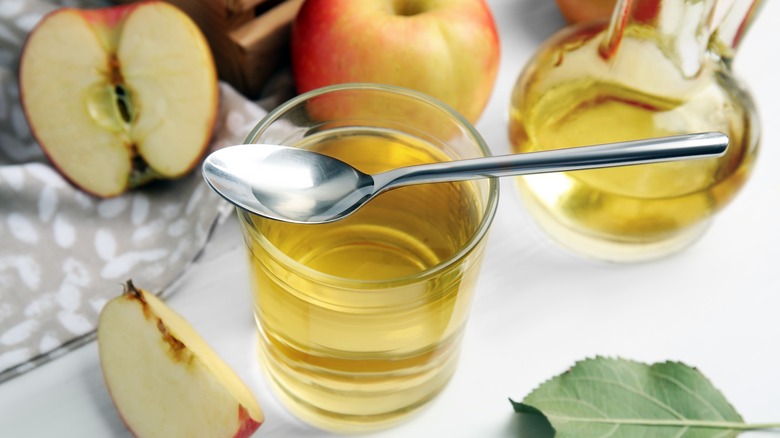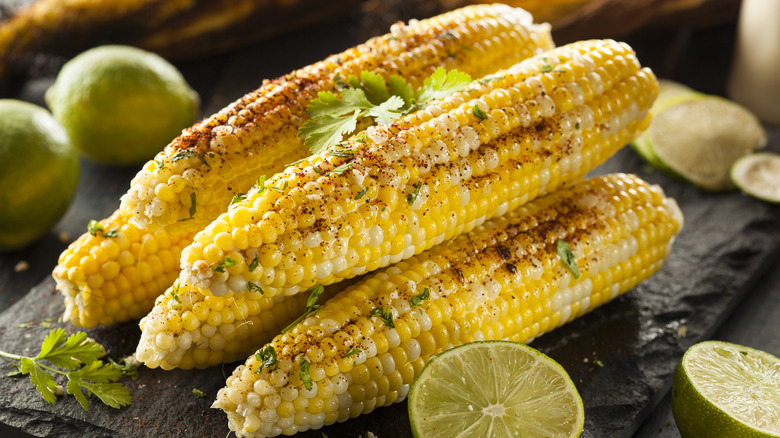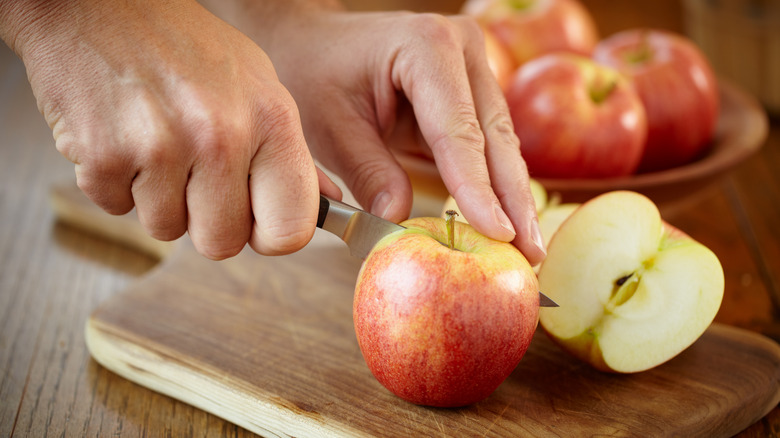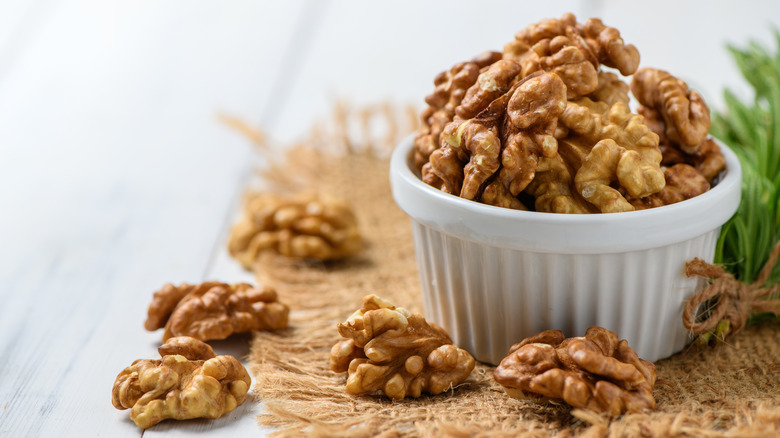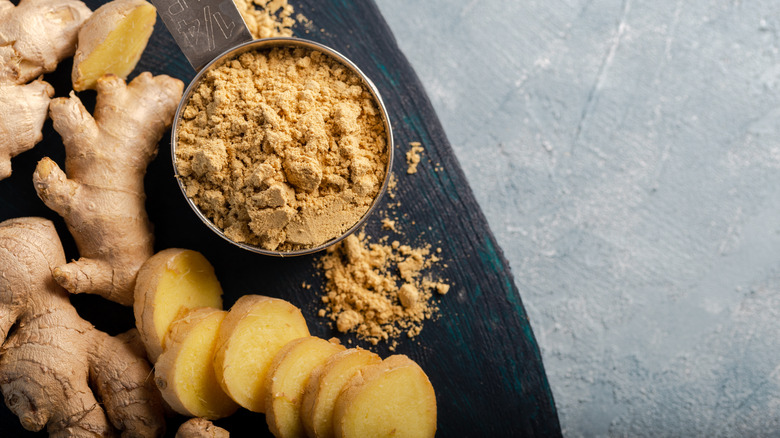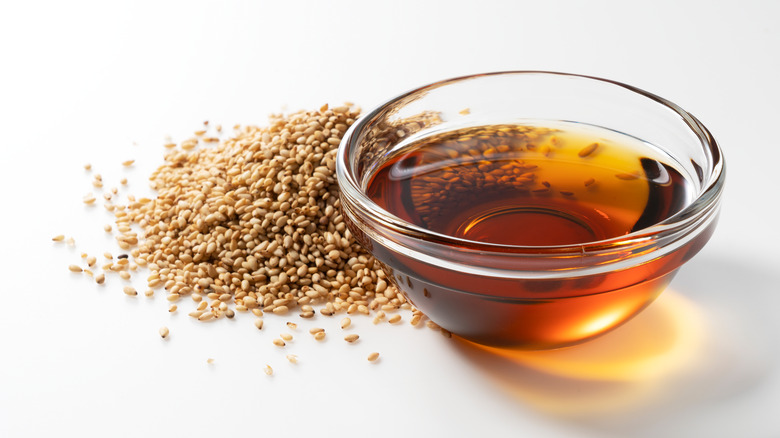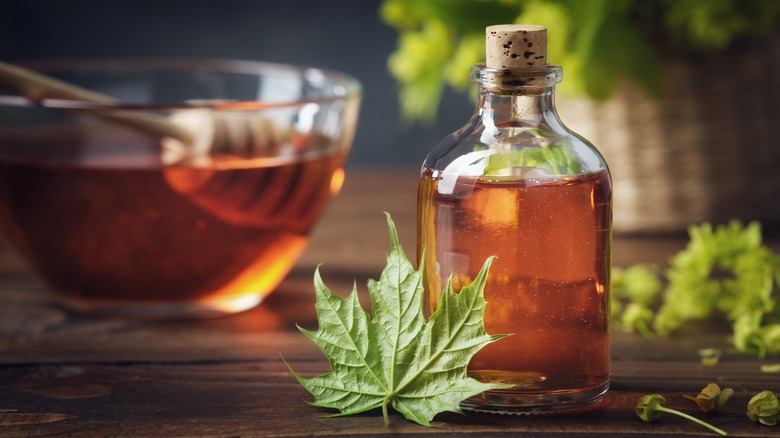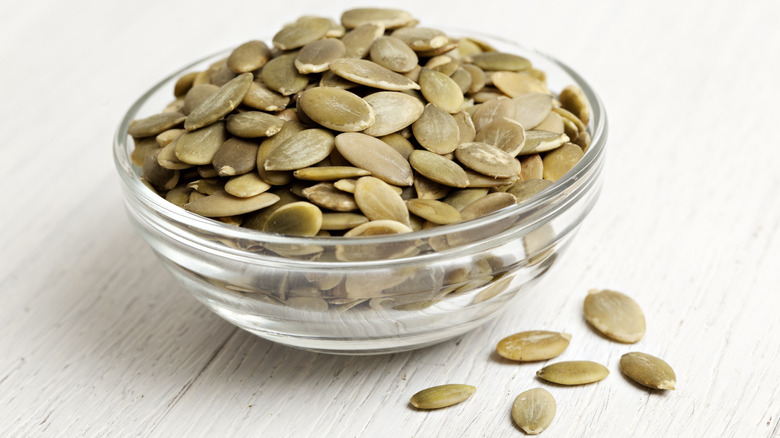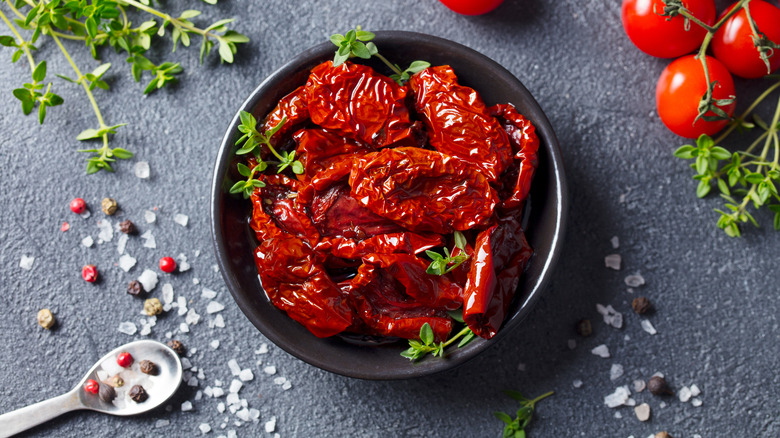10 Secret Coleslaw Ingredients You Probably Never Thought To Use
Coleslaw is one of the most versatile side dishes imaginable, easily pairing with everything from burgers and barbecue to grilled fish and tacos. It can also be far more creative than just a basic blend of dressing, cabbage, and carrots. While there's certainly nothing wrong with keeping it simple, it can be more rewarding to think of those three main ingredients as a foundation on which to build more complex flavors and textures. Because cabbage and carrots are earthy and crunchy, coleslaw can benefit from additional ingredients to provide some tasty contrast against those qualities.
If you enjoy having coleslaw with your meals but you're ready to change it up, then you're in the right place. We've taken the time to come up with a nifty list of ingredients that can elevate the flavor of coleslaw in just a few simple steps. Better yet, all of these ingredients are relatively easy to find, and there's even a good chance that you already have many of them on hand.
1. Flavored vinegars
When it comes to coleslaw dressing, there are two main camps: creamy and vinegar-based. Creamy coleslaw dressing tends to use mayonnaise with a touch of lemon juice or vinegar. Vinegar-based coleslaw forgoes the mayo, giving a more acidic flavor profile that's lighter and brighter. But each of these approaches relies on a common ingredient to different degrees: vinegar. While it can be tempting to stick to tried and true staples like red wine vinegar or apple cider vinegar, coleslaw can reach new heights by experimenting with various vinegar flavors to create some delicious results.
There are fruit-based vinegars available online or at markets that are made with ingredients like strawberries, raspberries, and blueberries. These vinegars provide a fruity sweetness that helps balance out the tartness, bursting with flavors that can vastly improve coleslaw. For a more subdued flavor, champagne vinegar is a good choice. Champagne vinegar is usually made with a blend of Chardonnay and Pinot Noir grapes, which gives it a lightly floral flavor that pairs well with coleslaw. If you really want to go the extra mile and get creative, you could even try your hand at making some flavored vinegar at home. By soaking some of your favorite herbs, fruits, and spices together in vinegar, you can infuse it with fresh flavors to use in your cooking, including batches of coleslaw. If you're going to try making your own flavored vinegar though, just be sure that you safely sterilize your containers and correctly store everything.
2. Mandarin oranges
Mandarins have a sweet flavor that's a little less sharp than regular oranges. This makes mandarin oranges an ideal ingredient for vinegar-based coleslaw, since it already has an acidic flavor profile that can greatly benefit from some fruity sweetness. The beauty of fresh mandarin oranges is that they are very easy to prepare. Their skins are typically very thin and fragile, making them a breeze to peel.
Once they're peeled, the mandarin pieces can be separated into wedges or sliced into smaller bite-sized pieces. Just try not to dice them too fine, since doing so may result in a jam-like consistency that reduces their texture to mush. The idea is to showcase their flavor but still maintain their texture so that each bite of coleslaw results in a delicious burst of citrus. Another great thing about mandarin oranges is that even if they aren't in season at your local grocery stores, most markets carry mandarin fruit cups, preserved in juice, which can work just as well. Mandarin oranges are particularly delicious in Asian-inspired slaw when paired with coconut shrimp or grilled chicken.
3. Grilled corn
Sure, grilled corn is great as a side all by itself. But incorporating it into some slaw is another fantastic way to add an extra layer of lovely flavors. It can bring a smoky yet milky sweetness that takes coleslaw to another level.
Grilled corn is also very easy to prepare. In order to give the corn the benefit of added flavor from some subtle charring, we'd recommend shucking the corn first. After you shuck and clean the corn, brush it with a mix of olive oil and butter and season it with salt. Grilling shucked corn will give the kernels direct exposure to the heat, and their natural sugars will lightly singe and caramelize to create grilled corn that is deeply flavorful. The trick here is to really keep your eyes on the corn, turning it every few minutes. You're aiming for some light charring, but don't want to overdo it to the point of burning.
After the corn has some nice grill marks, let it cool and then slice it off the cob into a bowl. To make an elotes-style slaw, stir in some melted butter, chili powder, smoked paprika, fresh lime juice, salt, black pepper, and fresh cilantro. Add in a little sour cream along with crumbled cotija or feta. Mix the grilled corn with shredded cabbage and carrots and use as a topping for tacos.
4. Apples
To continue the fruit recommendations for coleslaw, next up we have apples. There are a variety of types of apples that can work in this context, so it really just comes down to your personal preferences. If you'd prefer your coleslaw to have a more tart component, then we'd suggest going with some Pink Ladies or Granny Smith apples. Both of these have a flavor that's sharp enough to cut through the earthiness of shredded vegetables to provide some acidic balance. If you're trying to introduce some natural sweetness, then Fuji, Gala, or Golden Delicious apples are good ways to go.
As with the mandarin oranges, it's good to be mindful if you're cutting your apples. Instead of dicing them into small pieces that can get lost in the slaw, try shaving the apples into thin slices. This can provide subtle flavor while still maintaining the apple's texture. Try pairing your fruity coleslaw with some fried pork chops — the flavor combination of juicy apples and crispy pork is a match made in heaven.
5. Walnuts
To introduce some nuttiness and another layer of texture into your coleslaw, walnuts are a smooth move. They're firm enough to provide some pleasant crunch, but also still delicate enough to crumble with fairly minimal pressure, allowing them to impart some nutty flavor and texture without making the coleslaw overly crunchy. Better yet, walnuts make an excellent pairing with some of our other coleslaw ingredient recommendations on this list, such as shaved apples.
Another great thing about walnuts is that you can easily flavor them with extra seasonings, to layer in even more complexity into your coleslaw. Try tossing them in some melted butter, curry powder, and a little salt, then toasting them in the oven. For a spicier kick, another option is mixing them with soy sauce, maple syrup, and wasabi paste before sliding them into the oven. The possibilities are practically endless here. Walnuts are mild-flavored nuts that can function as a blank canvas to build something more complex, with the added bonus of some extra texture. They also happen to be very nutritious and loaded with antioxidants and healthy fats. If it hasn't occurred to you to bring some walnuts into the mix when you're making coleslaw, consider this as a sign that it's time to change that!
6. Ginger
With its distinctive blend of bright and earthy flavors, fresh ginger can bring an invigorating and refreshing taste to coleslaw. We'd recommend buying a fresh knob and then turning the ginger into a paste. The good news is that making ginger paste couldn't be any easier.
Simply peel the skins off the ginger (this can be done with the edge of a spoon), slice it into strips, and then purée in a food processor. Drizzle in a little bit of water to help the ginger circulate. Adding water will also help thin out the purée into a smooth, paste-like consistency. You may also want to add a little oil and salt to help preserve the ginger paste. You can store this ginger paste in a silicone ice cube tray in the freezer, so that you can pop little ginger cubes out as needed to use for sauces or beverages.
Another option is to simply use some powdered ginger. By seasoning your dressing with ginger powder, you can enjoy the flavor of ginger more easily compared to preparing fresh ginger paste, though of course, dry ginger powder is far less flavorful than the vibrant taste of fresh ginger. If you have just a few extra minutes to spare, it's worth it to take the time and make some fresh ginger paste (especially since ginger is so versatile and you can use it in so many other applications aside from coleslaw).
7. Toasted sesame oil
First things first: Notice that we've recommended toasted sesame oil instead of pure sesame oil. There is a difference between them, and sesame oil in stores should be clearly labeled to make this distinction. Pure sesame oil has a milder flavor and a higher smoke point, making it a better option for shallow frying or sautéing. Toasted sesame oil is darker in color, with a richer and more intense flavor profile that's better used in non-cooking applications like salad dressings. For coleslaw, it's best to go with toasted sesame oil.
Toasted sesame oil works particularly well when you're aiming for an Asian-inspired slaw. Try mixing shredded cabbage and carrots with toasted sesame oil, soy sauce, honey, scallions, and fresh cilantro. For a wallop of extra flavor, this is another opportunity to use some ginger paste. Add in some sesame seeds for even more flavor and a little crunch. Try making Asian slaw as a side for some grilled teriyaki salmon. The combination of freshly grilled teriyaki salmon and toasted sesame slaw is truly delicious.
8. Maple syrup
Whether you're making a creamy coleslaw or a slaw that's vinegar-based, many of the dressing recipes you'll encounter call for a touch of sweetness. But rather than resorting to plain white sugar, it can be helpful to experiment with other sweeteners. Maple syrup offers sweetness with distinctive notes of flavor, reminiscent of toffee or caramel, and provides a much richer taste than plain sugar.
The important thing to focus on here is quantity. Add it to your dressing slowly, frequently tasting along the way. The goal is to provide a delicate balance of flavor that complements the slaw's savory creaminess or the sharpness of its vinegar. Adding too much maple syrup can ruin it, creating a slaw that's sticky and cloying. Once again, view this as an opportunity to build some surprising complexity. Explore maple syrups flavored with apricot, peach, or jalapeño. Keep in mind that the flavor of maple syrup also pairs well with other ingredient suggestions that we've made here, like walnuts, apple, and ginger.
9. Roasted pumpkin seeds
Roasted pumpkin seeds (also known as pepitas when shelled) are a great way to provide some wonderful crunch and a mild, nutty flavor to your coleslaw. Similar to walnuts, pumpkin seeds can act as a vessel for more complex flavors by adding them to various seasonings before roasting them in the oven. If you want to keep it simple, you can always buy pumpkin seeds that are already roasted and seasoned at your favorite grocery store. But if you're interested in roasting them yourself, your effort will be rewarded with a delicious payoff.
Simply toss the pumpkin seeds in some olive oil, salt, and pepper and then roast in the oven at 350 degrees Fahrenheit for about 20 minutes, stirring them about halfway through. For deeper flavors, try incorporating a few spices. Cumin, coriander, and chili powder can all add tasty complexity to the roasted pumpkin seeds in your coleslaw.
10. Sun-dried tomatoes
They're typically used in pastas, sauces, salads, and soups, but sun-dried tomatoes can also work wonders in coleslaw. The beauty of them is that they impart the rich taste of tomato while being firm enough to not turn mushy when mixed with shredded cabbage and other veggies. Sun-dried tomatoes have a sturdy yet tender consistency that makes them ideal for plenty of dishes, including coleslaw.
Sun-dried tomatoes are mainly sold in two different forms: dry-packed or jarred in oil. For coleslaw, we'd recommend using the oil-packed variety. These tomatoes are softer and ready to eat right out of the jar, which makes them easier to use straight away. Just slice the tomatoes into bite-sized pieces and stir them into the mix. Plus, you get the added bonus of fragrant sun-dried tomato oil, which can be used to make a flavorful dressing for your slaw. For a Greek spin on coleslaw, try combining sun-dried tomatoes with other ingredients like chopped olives, crumbled feta, red onions, lemon juice, cucumber, and fresh dill.
